GEOTHERMAL HEAT PUMPS
The 30% Tax Rebate is back! Ask for details!
Geothermal Heating and Cooling can be adapted to so many situations it is hard to list. See our FAQ page for better details. Generally, Geothermal or Ground Source Heat Pumps utilize the Earth’s constant temperature (70-72 degrees in South Texas) to absorb heat , or dispose of heat to heat or cool your home. This is done through a series of underground water loops, or via well water, a pond, or even a swimming pool! Simply put, when cooling….What do you think would take less energy, to transfer heat from you house to 70 degree dirt or 95 degree summer air? Obviously much less power is needed to transfer your home’s excess heat to 70 degree soil, than 95 degree air. In heating mode, how much energy does it take to transfer 70 ground temp to warm your home to ….well 70? Not much!
New units achieve comparable SEER ratings of 35+, and can produce 5 units of heat, for every unit of heat energy applied!
- QUIET OPERATION
- LONGER LIFESPAN
- SUPER EFFICIENCY, LOW UTILITIES
- 10 YR PARTS AND LABOR WARRANTY (OPTIONAL)
- NO EMISSIONS, NO GREENHOUSE GASES
- ENTIRELY INDOOR UNIT, NOT SUBJECT TO OUTDOOR CORROSION NO MORE NOISY OUTDOOR UNIT BY YOUR WINDOW, OR BACK PORCH
- QUALIFIES YOUR HOME FOR ENERGY STAR RATING
- MOST DEPENDABLE AC/HEAT UNIT AVAILABLE
- MINIMAL MAINTENANCE
- NO GAS FURNACE TO WORRY ABOUT CARBON MONOXIDE OR GAS EXPLOSIONS
- PROVIDES 50-80% OF YOUR HOT WATER NEEDS AS FREE BY PRODUCT HEAT
The Geothermal Heat Pump uses contact to the ground to transfer energy, instead of a noisy outdoor unit with a fan, passing energy to the air. There are 4 basic ways to achieve this:
1) Closed loop system: (Most Common) Utilize a small circulating pump and lots of piping in the ground to transfer energy to or from the earth. Typically requires 500-600 lf of pipe in contact with the earth for every ton of load. Can be installed in horizontal ditches (requires lots of ditching and room in your yard), or vertical bores typically 250-300’ deep that can be spaced 20’ apart, so smaller areas can handle substantial energy loads. PROS: Long life, high dependability. CONS: Higher up front cost
2) Open loop systems: Basically take water from the ground, (well water) use it to heat or cool your home, and then dump the water, to a pond, ditch, or sometimes to an injection well, the opposite of a water supply well, that returns water back to the aquifer it came from, un touched, other than warmer or cooler than it’s original temperature. PROS: Lower up front cost CONS: Water waste, system subject to ground water chemistry, adds load to water well.
3) Pond loops: A closed loop similar to an in ground loop, but uses piping on the bottom of a pond for heat transfer. PROS; Lower up front cost CONS: Need a pond close to house!
4) Pool loop: Not fully accepted in the geo community, but still effective. Similar in concept to the pond loop, but uses your swimming pool for extracting or depositing heat. Your pool will super cool in the winter (45-49 degrees) but warm early in spring, and stay warm later in fall for extended swimming season. Depending on size of pool, may require a ground loop to supplement, and a pool evaporative cooler in summer. . PROS: Lower up front cost, Helps heat pool in early/late season CONS: May over heat pool in summer, pool alone may not handle heat load.
OUR GEOTHERMAL PROJECTS
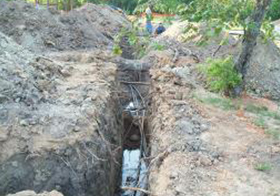
Installing Ground loops is ...well … a lot of digging work.
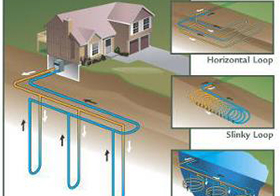
Geothermal Energy for Home
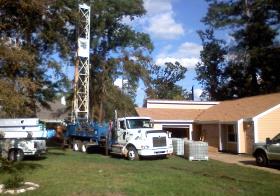
Drilling bores to convert this existing home to geothermal
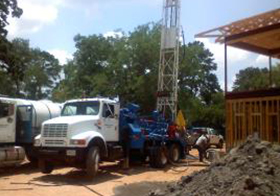
Drilling is the heart of the geothermal business in Texas.
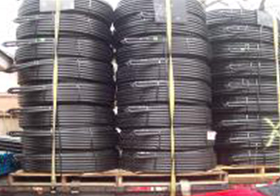
Rolls of geothermal “U loops” ready to slip into 250’ bore holes
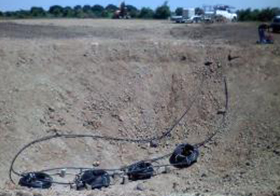
Pond loop geothermal loop system, installed before pond is filled, in this case. This system is for a 3000 sq ft home.
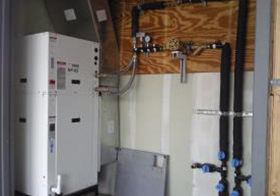
A geo unit installed on a commercial job. Note the circulating pump, and service flush valves.
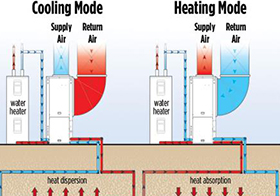
The basic principle...moving heat to and from the ground
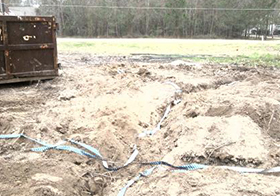
Ditches for 4 bores are backfilled to last 12” and then metallic marker tape is installed for future location, if necessary, by meter.
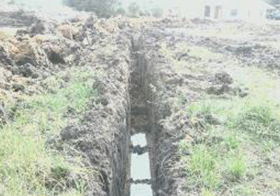
This job was installed not in vertical drilled bores, but in long horizontal trenches. This job used four trenches, 5’ deep, 220’ long, with 4 pipes in each trench.
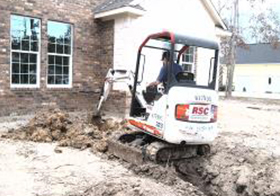
Ditching from this new home to the 4 loop geothermal vertical well field
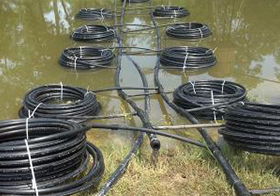
An 11 ton pond loop system being floated out before filling with water to sink. Note loops are weighted with blocks to barely float when dry, and sink when filled.
Looking for a reliable HVAC Contractor in Houston?
We have over 25 years of commercial HVAC and residential central air conditioning installation experience.
Don’t leave your Houston HVAC repairs or air conditioning installations to “fly by night” or “out of state” AC companies. We guarantee our work in writing and have up front pricing on all AC repairs and AC installations.
Call Tammy at (281) 355-0430 for more information and see what Houston’s best air conditioning contractor can do for your home’s central air conditioning or commercial HVAC project.

 281-355-0430
281-355-0430



